Faith is a powerful thing. Faith is tied to religion. Different religions come with certain rules and traditions that have shaped people’s lives on our planet for thousands of years. In Judaism, they have a resting day called Shabbat, which starts Friday evening at sunset. Invariably intertwined with observing the Shabbat is the braided bread Challah. This is my recipe for sourdough challah.
Disclaimer! This is not an article about religion or my views on it, but if you are a regular reader you know I always like to look into the backstory of the things I present here.
If you are just here for the recipe, you can press the button underneath to be automagically transported to the recipe:
Jump to Recipe Jump to VideoSo what is this challah about?
Challah is a bread in Jewish cuisine that has a special ceremonial purpose. The bread is often as part of Shabbat and other major Jewish holidays.
The word challah is Hebrew but is known in Jiddisch under a variety of different names in different dialects like khale, barches, bukhte, dacher, or berkhes.
The bread is related to Kalach in Russia and Eastern Europe, which is also an enriched bread, braided but often circular. They are often used as part of worship as well, for Christmas or Easter.
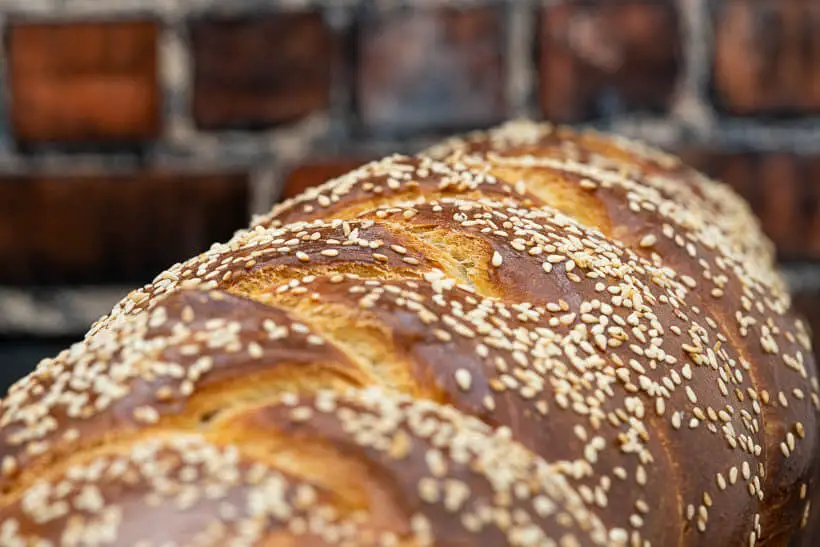
Classically challah is topped with sesame seeds, poppy seeds, or anise. Not uncommonly raisins and/or saffron are also added to the dough.
The dough is an enriched dough, but unlike brioche, it does not contain milk or butter, because it’s normally prepared parve, which means it’s both without meat and dairy. Instead, it relies on fat from vegetable oil, eggs, and honey or sugar to get the rich luxurious texture.
The formula in this sourdough challah recipe
The challah bread is made with enriched dough. It’s enriched with oil, honey, and eggs.
To minimize the sourness of the starter I am using a stiff levain, which is made from your regular 100% hydration starter (to minimize the need for having multiple starters). A stiff starter can grow as high as your regular starter.
It uses this formula:
| Weight | Ingredient | Baker's Percentage |
|---|---|---|
| 39g | starter (100% hydration) | 35.1% |
| 111g | bread flour | 100.0% |
| 57g | water | 51.4% |
The dough itself is made using bread flour, a bit of water, quite a lot of egg, honey, oil, and salt.
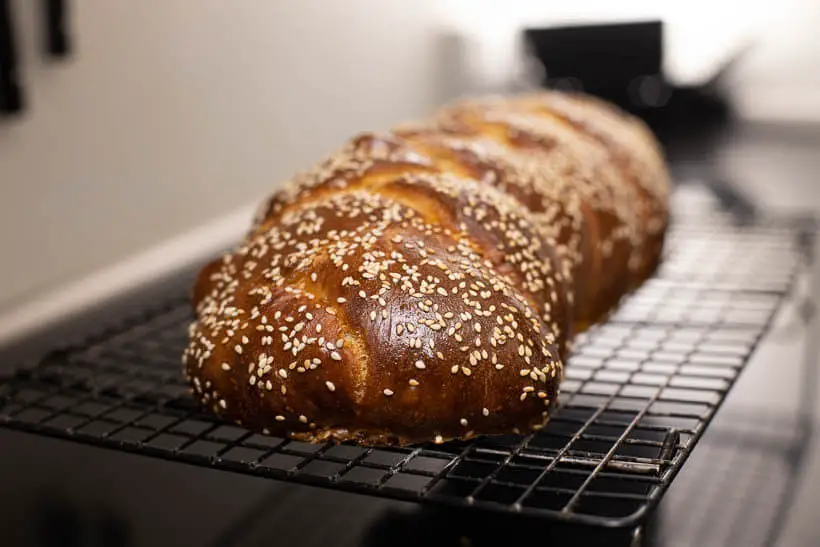
The hydration of this dough is not possible to calculate because of the high percentages of additions, but it feels like a lean dough of somewhere in the range of 55-60% hydration. Tacky, but not sticky.
This is the formula:
| Weight | Ingredient | Baker's Percentage |
|---|---|---|
| 413g | flour | 100.0% |
| 62g | water | 15.0% |
| 186g | egg | 45.0% |
| 57g | oil | 13.8% |
| 67g | honey | 16.2% |
| 8g | salt | 1.9% |
If you want to play around with the formula, you can do so in my bread calculator.
Conclusion of this sourdough challah recipe
There is no doubt, that this bread is a looker. The braids break up the surface and the toasted sesame seeds and the deeply caramelized crust look absolutely gorgeous.
The bread itself feels light. The crust is thin, super soft, and smells wonderful.
The crumb is incredibly soft, filled with tiny holes. You can see the gluten structure in the crumb from the braids, which makes it break up in circular patterns.
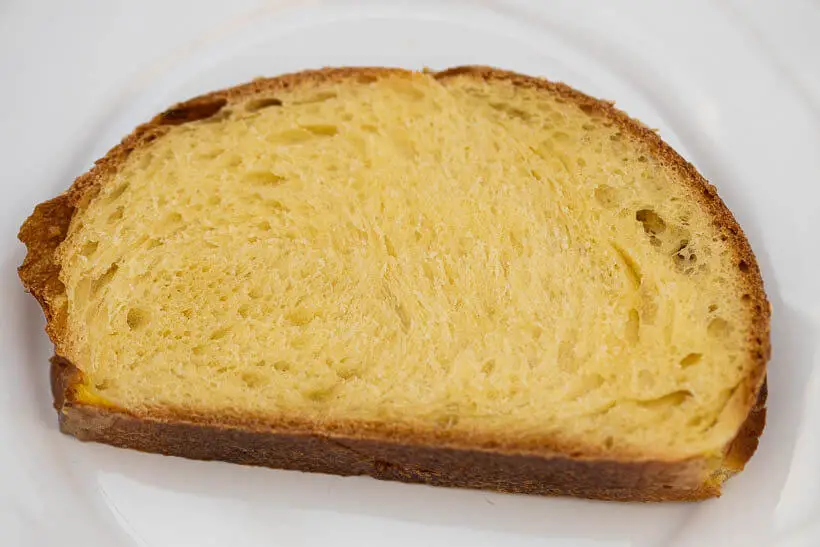
The taste is great. You can taste the nutty notes from the flour and it has an absolutely wonderful mouthfeel. This is not bread for the weekdays, but a weekend bread.
It’s perfect with some gorgeous butter and a sprinkling of coarse salt.
Share this recipe for sourdough challah on social media
This is my recipe for sourdough challah. I hope you will try to make this gorgeous and delicious bread.
If you make it and share it on Instagram, please tag me as @foodgeek.dk so I can see what you made. That would make me very happy.
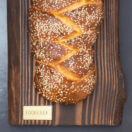
Sourdough Challah
Ingredients
Stiff levain
- 53 g sourdough starter
- 150 g bread flour
- 76 g water
Dough
- 413 g bread flour
- 62 g water
- 186 g eggs about 4 large
- 57 g neutral flavored oil e.g. rapeseed, peanut, sunflower
- 67 g honey
- 8 g salt
- 207 g levain
Egg wash
- egg
- salt
Topping
- sesame seeds
- poppy seeds
- kosher salt
Instructions
Making the stiff levain – the evening before
- Mix everything for the levain build. Knead it so that it's thoroughly mixed.
- Put it in a glass container and press it flat.
- Put an elastic band around the container where the top of the levain is, so you can monitor how much it grows.
- Leave it to grow the night over until it's reached its peak. It takes somewhere around eight to twelve hours.
Mixing the dough – around 8:00/8a.m.
- In a large bowl add 62g water, 186g eggs, 8g salt, 57g oil and 67g honey. Mix it until the salt has dissolved.
- Mix in 413g bread flour by hand until you have a shaggy ball.
- Add 207g of the stiff lavain and knead by hand until you have a firm and smooth dough. About 8-10 minutes.
- The dough should be tacky but not sticky. If it seems a bit too wet, knead in a bit of flour. If it seems to dry, knead in water by the tablespoon.
Bulk fermentation – around 8:30/8:30 a.m.
- Place the dough in a clean bowl and let it ferment somewhere warm for 2 hours. It will probably not rise at all; this is fine.
Shaping and final proof – around 10:30/10:30 a.m.
- You can bake this as a 1000g loaf or divide it into two smaller 500-gram loaves. You can divide them into 16 60-gram rolls if you want to make challah rolls.
- Braid or shape the dough. Watch my video to see how you do a classic Challah shape.
- Cover with plastic wrap and let proof until tripled in size, about 5 hours.
- Around 4½ hours into the proof, gauge the dough. If it's almost tripled and when poked, the dough only springs back a little, preheat the oven to 180°C/350°F/Gas mark 4.
Baking – around 16:00/4:00 p.m.
- Gauge the dough again. Poke the dough with a wet finger. The dough is ready to be baked, if it makes an indentation that doesn't spring back. If not, wait a bit more.
- Heat the oven to 180°C/350°F.
- Make an egg wash by mixing an egg with a pinch of salt.
- Brush the bread with the egg wash.
- Sprinkle with the topping(s) of your choice. I used sesame seeds.
- Baking a large loaf takes about 40 minutes, smaller loaves take about 30 minutes, and rolls take 15 minutes.
- If your oven heats unevenly, you may want to turn the sheets halfway during baking, to get even browning.
- For the bread to be done, the internal temperature should be around 99°C/210°F.
- When the loaves/rolls are done, remove them from the oven and let cool completely on a wire rack.



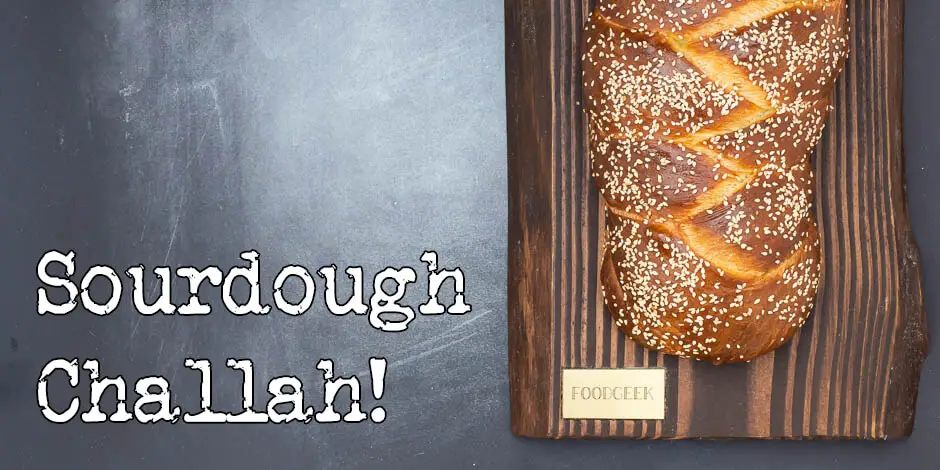


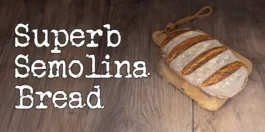
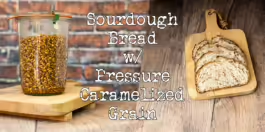

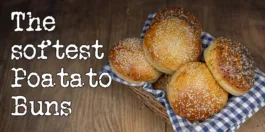

Hi, I am very tempted to make this recipe but I wonder – is it possible to final proof it over night in the fridge? Or is that not too good for this kind of bread?
Hi! I have made this three times. Twice, completely by the book. Both of those times resulted in a DELICIOUS loaf, but with little-to-no braid definition. The first time I thought it was because I had braided badly, but after practicing and doing it again, I think it has more to do with the extended raise after braiding. For my third try, I changed a few things. Kept all the ingredients the same, but did a bulk rise for 5 hours, braided it, and then let the shaped loaf proof for two hours. This resulted in much tighter braid definition, and more of a classic (non-sourdough) challah shape. Just wanted to let you know 🙂
You need to work your gluten more. Make sure the dough passes the windowpane test 🙂
Hi Sune. I’ve been following you for the last few months and sharing your videos on Facebook with my friends. I bake once a week and the more I practice the better I am getting each week thank you so much for being such a great teacher. I originally come from San Francisco California where I grew up on sourdough bread as a main staple. What got me started on this journey as I move to Florida where he cannot find sourdough so easy. Wanted to let you know that everybody loves your recipes and I stopped buying any type of store bread using only your recipe. This week I tried your sourdough challah because I already make challah and I’m pretty good at it but I wanted to try the sourdough and play around with shapes. Is there an email and I can send you pictures of what I’ve done because I would like to share with you a shape that’s very popular in San Francisco Bay area we made with sourdough use the challah recipe to make it even though it didn’t come out perfect it was delicious. Please advise thanks Denise in Fort Myers Florida I’ve already signed up and subscribe it here is my email again dm******@gm***.com
The hydration for this challah is not in the 55% to 60% range. If you are getting that high a count for your percentage, you are counting ingredients that are not part of hydration, as they do not hydrate the flour. Oil, honey and eggs do not count towards the hydration percentage. The only ingredients that count towards calculating the hydration percentage is water/flour in the levain, the flour and water added to the dough.
53g mature SD = 26.5 Water + 26.5 Flour
150g bread flour
76g water
413g bread flour
62g water
((26.5 + 76 + 62) / (26.5 + 150 + 413)) = 27.9%
Please reread what I wrote. I said you cannot effectively calculate the hydration, but it feels like a bread in the 55-60% range 🙂
In the text of the article, you give instructions to make a levain totaling 207g, which is the amount you call for in the main dough recipe. However, the levain quantities in the recipe make 280g. Is the leftover to be discarded, or is there an error somewhere?
Hello, this sounds very nice – I was wondering if a second rise in the fridge overnight would be an option? Thank you for all your wonderful recipes! Cheers, Emy
What is your recommended bread flour ingredients? Would a all purpose Gluten-Free flour work?
Can I add some whole-wheat or use all purpose flour since getting bread flour these days is hard. I wouldn’t use a lot of whole wheat… It would make challah too heavy.
Hi Sune. Is there a way to make this challah without the eggs? How might I adjust the quantities to account for no egg? Also, please describe how to make the stiff levain. I believe there is a typo in the recipe so I’m confused.
It says:
Mix everything in inm the levain build together. Knead it so that it’s completely mixed.
I’m not sure what that means. What ratio of starter:flour:water would you do for the stiff levain?
Thank you!
I have been making hallah for well over 40 years here in Israel. I think I can safely say that mu hallah is the talk of our kibbutz and I make about a dozen each week just to give out to people who ask. This was the first time I ever made sourdough hallah and I did it with some trepidation. Just to make matters worse, I doubled the recipe and added about 740 gram of dried fruits that I soaked over night.
Other than that, I stuck to your method.
Well, the leravan was fantastic, I have never had a starter that was so vigorous and almost burst out of the jar. Making the braids was very difficult and in the end I made two braided hallot and two simple loaves – all with dried fruit.
As the weather here is very hot, it was ready to go into the oven after just 4 hours. The loaves looked flatter than I am used to (well they were full of wet, dried fruit) but rose well in the oven.
The came out a rich golden brown and after waiting for a while, I cut into one and it was…. delicious.
Next time, and there will be many next times, i will make without the additions and also figure out some way to support the braided dough to stop it spreading so much.
Thank you so much for introducing me to yet another new bread experience.
.
What do you mean by neutral oil? Also, any specific type of honey you recommend?
Neutral flavored oil 🙂
Please tell me how to incorporate raisins in this bread.
Can you bulk ferment in the fridge? When do you know the bulk ferment is over?
Yes, and it’s the same as at room temperature. When the dough has grown 25% 🙂
Thank you for the recipe.
Can I bake the next day I proof and shape the dough?
Yes, let it proof for about 3 hours and then put it in the fridge until the next day.
Be aware that the bread may be tangier.
If I don’t have honey on hand and want to sub in sugar how much should I use ?
Use about the double amount of granulated sugar and add about 10 grams of water.
would you adjust the temperature or time if baking in a loaf pan instead of freeform?
I am making this for the first time today. Can’t wait to see how it comes out. I have about 60g of levain leftover. Can I keep it for next week’s challah or do I need to start with a new levain? If I can keep it, how should it be fed?
Sune, I love this recipe! I tried it yesterday and it turned out perfect, OMG it was amazing. The video was so helpful, as I couldn’t imagine how to do the braids, but as soon as I saw it, it was so obvious and easy. I love the bit of sourdough tang in the aftertaste. I might add a tiny bit more honey or a stronger honey just to give it a touch more flavour. We lean towards a very mild clover honey here in urban North America and I’m thinking maybe your bees produce something different in Denmark! Thank you so much!
Tunde Nemeth
Yes, we have some very nice honey here in Denmark. I get one from a local producer 🙂
Hi there, I am making this for the first time, currently waiting on my stiff starter before doing the rest. I watched the video and when creating the lengths to braid you say to roll them out to 50cm/12 inches. 12 inches is 30cm. 50cm is 19.6 inches. Can you please clarify what length the sections are?
Thanks so much. I’m looking forward to tasting it.
Confused about why you would make 279g of levain and then use only 207g of it. Is this correct, or is it a typo? Thanks!
I am jewish and eat challah every week. I would love to try this recipe! Is it possible to make it with white spelt flour?
Thank you!
I’ve been really enjoying your youtube channel as a sourdough learning resource for the past 9 months of this “paindemic” and when I saw you had a recipe for challah I just had to try! The result is one of the prettiest things I’ve baked thus far in my amateur baking career. The interior was impossibly soft and silky, yet the overall structure was very well defined, and quite tasty too!
The dough came out incredibly sticky at first, I wonder if American eggs are larger (I didn’t weigh them) or maybe I mis-measured the water/oil, over-hydrated my leaven, or . I probably worked an extra 30-40g in while kneading and even then it was still sticking to the bench but I was worried I’d over-flour or over-knead it, so I started bulk ferment in a lightly oiled bowl, and threw in an extra stretch & fold about 30m later and called it good. I then let it retard overnight, and very lightly floured it the next morning as I worked it into braids. Just enough to keep it from sticking to the bench but not so much that it wouldn’t stick to itself once I started braiding.
Also, instead of the large braids in your example loaf, I made a round loaf with smaller and adorable little strands. interested readers can google “4 Strand Round Challah Jamie Geller” for the specific pattern I used but there’s like a million other approaches so everyone can pick their own aesthetic, I suppose!
Tusen Tack Sune!
This is a wonderful recipe. The directions are thorough and spot on. It is the best and easiest sourdough bread I have made so far. Thank you for the detailed, easy to follow, precise instructions.
Thank you <3
The weight of water is different in the top section vs the directions at bottom. How many grams of water for the stiff levain here?
There’s a bit extra in the recipe, so that you are sure you have 207g when you need it 🙂
I had great success with this bread, though I proofed longer than suggested. (For the bulk proof, a few hours in a warm place and then several hours in a cool one. For the final proofing, overnight at around 71 degrees Fahrenheit.) I used olive oil and added just a bit of spelt flour, as well as some candied fruit and a bit of orange blossom water. I baked them in paper molds. Fantastic!
Hey Sune. People are copying you:
https://thegingeredwhisk.com/sourdough-challa/?fbclid=IwAR1wuf1EjohonWoliiL9YI4WFtp2Qj_o3il_Xb_bwPtJB5K5xEOYOkeruKk
Wow! I made your recipe and used your methods as closely as I could and my bread turned out fantastic! I wish I could show my photos.
Awesome! Go to the Contact page and send the picture through the form.